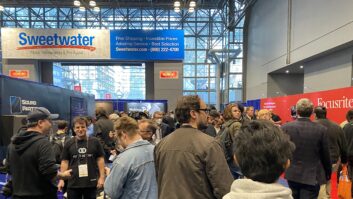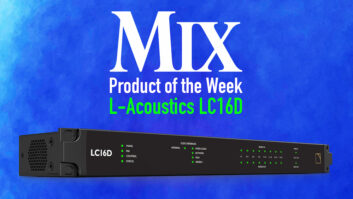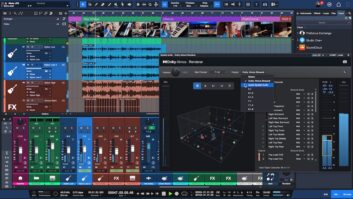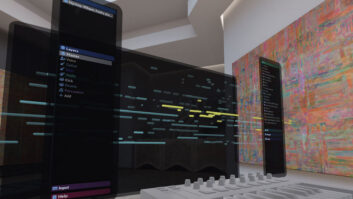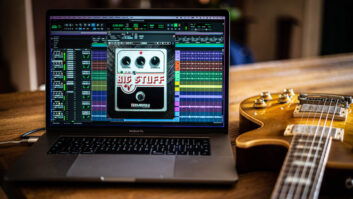The torrential rains that plagued the East Coast the week before AES disappeared just as suddenly and completely as the microphones, recorders and computers that mysteriously “walked” off the show floor and out of the Jacob K. Javits convention center during the opening days of the 107th AES convention. Lax security aside, this was a delightful AES show: The shuttle buses ran (mostly) on time, the weather cooperated and a superb mix of papers, workshops, technical sessions and tours complemented the record-setting turnout of manufacturers hawking the latest in audio technology on the exhibition floor. With the arrival of new-stereo and multichannel-release formats, higher-resolution tools, digital broadcasting and Internet distribution, everybody at the show had something to learn, see, hear or buy. For attendees, AES arrived right on time, and there were plenty of new toys to check out. Here are a few that caught our attention…
DAWS AND ALL THATThe number of workstation products at AES was nearly overwhelming. And new compact rackmount DAWs, such as the Tascam MX 24-24, Mackie HDR24/96, Akai DR16 Pro and Roland VSR-880 all bring disk-based production to new levels of affordability. Aimed at the mid-level user were updated versions of the Euphonix R-1 and Otari Radar II, along with Merlin, Fairlight’s re-entry into the music production market. Meanwhile new workstations for high-end users included AMS/Neve’s AudioFile SC and Solid State Logic’s MixTrack option for its Axiom-MT digital board. For detailed information on these recorders and workstations, check out our “Multichannel Digital Audio Workstations” feature, beginning on page 88. There was a plethora of new plug-ins at AES, too, and we’ll bring you a feature on those next month.
Competition in the “DAWs-for-musicians” market is heating up. Mark of the Unicorn’s (www.motu.com) 24i audio interface provides 24 channels of balanced analog inputs and four stereo outs: balanced 1 1/44-inch analog, and S/PDIF (coaxial and optical). The 24i is available as an expander for an existing MOTU Audio System ($1,195) or as a core system ($1,495), which includes the PCI-324 card and Audiodesk workstation software. Three 24i rack I/Os can be connected to a PCI-324 audio card for 72 inputs and six outputs; the 24i is compatible with the 2408, 308 and 1224.
In addition to showing Pro Tools 5.0 software, featuring a MIDI sequencer and support for Avid media (spotlighted in the September Mix), Digidesign (www.digidesign.com) debuted its Digi 001 project studio workstation. Its single-rackspace interface has eight analog audio inputs, eight analog outs, separate monitoring outputs, two channels of S/PDIF digital I/O and eight channels of ADAT optical I/O-18 simultaneous inputs and outputs, plus MIDI In/Out. The hardware is bundled with new Pro Tools LE V.5.0, a host-based version of Pro Tools with integrated MIDI sequencing; 24-track, 24-bit playback; five inserts and sends for effects; 16 internal buses; real-time, host-based processing with Real-Time AudioSuite (RTAS) plug-ins; and automation. Retail: $995.
Steinberg’s (www.steinberg.de) long-awaited NT version of its Nuendo Media Production System is shipping. Nuendo is a modular system offering as many as 128 tracks of digital audio, with native processing, surround mixing, Video-Track, MIDI tracks and VST plug-in architecture. Retail is $1,295. A BeOS version is expected later this year.
LARGE-FORMAT CONSOLESIn the area of recording consoles, this year’s AES show had something for just about everyone, whether it was new offerings, significant updates to existing consoles, or models that had been introduced but had only recently begun shipping.
Euphonix (www.euphonix.com) launched its highly anticipated System 5 digital audio console, with SRO crowds packing its booth throughout the show. One Union bought the first, representatives from the Hit Factory bought two, and Euphonix announced the sale of ten boards. (For more information on System 5, see the “Technology Spotlight” in last month’s Mix.)
Version 2.0 software for Studer’s (www.studer.ch) D950 digital console includes expanded features in project management, two-person operation, automation, control groups, EQ, diagnostics, multiformat monitoring and surround panning. Its Virtual Surround Panning (VSP) capability adds depth and dimension to surround and stereo listening environments, by taking a source signal and positioning it “behind” the speaker-in effect, placing the listener further back into the room. When reverb is added, the depth of the monitoring field takes on a new character, bringing a useful and truly musical dimension to the mix process.
At Solid State Logic (www.solid-state-logic.com), the 30th anniversary party was in full swing, with its TEC Award-winning Axiom-MT digital console running under Version 2 software, which adds MIDI FX control, enhanced machine control and PanPoint(tm) surround panning. SSL claims PanPoint’s large, square, low-friction panning action makes conventional joysticks obsolete by allowing control and automation of stereo or surround panning moves via the console’s pen/tablet interface. However, the big news was SSL’s new 24-bit/96kHz MixTrack hard disk recording option for the Axiom-MT (for more information, see the article on page 88). Studio owners definitely took notice: New York City’s Electric Lady Studios placed an order, and delivered a check for Axiom-MT/MixTrack on the last day of the show.
Soundtracs (www.soundtracs.com) formally introduced its DS-3 Digital Production Console. Priced from $120,000, the DS-3 is a 32-bit floating-point digital production console featuring 4-band equalization and dynamics. The console’s work surface incorporates touchscreen technology in conjunction with 25 moving faders. Operating at 48 kHz with 24-bit conversion (96kHz capability is optional), the 64-channel DS-3 provides 32 output buses, each with limiters for stereo, LCRS and 5.1 surround work. A DS-M version integrates the DS-3 console and 32 tracks of SADiE random access audio and video-all at subframe-accurate sync.
Version 2.0 software for Sony’s (www.sony.com) OXF-R3 Oxford console includes expanded functionality for 5.1 surround sound mixing; multistem recording and monitoring; sub level control from each full channel; new Sony EQs and compressors; jog/shuttle machine control; and support for dynamically automating external MIDI devices. Options include GML signal processing, adding 96 channels of GML8200 EQ and GML8900 dynamics processing.
An upgraded version of the company’s established Digital Mixing System, Amek’s (www.amek.com) DMS Plus console offers up to 96 mix inputs, expanded EQ on all channels and the ability to handle multichannel formats. A DMS-XP Booster System upgrades current DMS consoles to the new system, while Version 3.0 software enhances dynamics processing and expands surround capabilities. In addition to 24-bit I/O and improved A/D and D/A converters, DMS Plus accommodates third-party controllers, including the Akai DD1500, AMS AudioFile and DAR Soundstation. The Channel Panel(tm) full-function assignment panel provides 48 rotary encoder pots and 32 switches for optional control of all channel parameters.
Audient (distributed by Audio Independence of Middleton, Wis.), the UK-based electronics company founded by Dave Dearden and Gareth Davies, launched the ASP8024 analog console, an 80-channel board with full 24-track routing in a true in-line design. The EQ section can be split for assignment to both the long and short fader paths. Other features include 14 aux buses, 20-segment peak LED meters in the long fader path, a stereo bus compressor/limiter and eight independent subgroups. The ASP8024 is priced at $31,000.
In other console news, Oram Audio (www.oram.co.uk) purchased the assets of Trident Audio Ltd. and will repackage some of the products that John Oram designed during his tenure there. On the drawing board now is an outboard box with the mic pre and EQ from the Series 80, built using original components and transformers. And Metric Halo (www.mhlabs.com) has acquired the rights to manufacture and market the Project X mid-priced digital console developed by RSP Technologies. MH will support existing Project X owners with parts, service and upgrades, including an advanced, retrofittable automation system slated for first-quarter 2000 release.
SMALL-FORMAT CONSOLESSmall-format digital consoles also drew crowds at AES. Mackie’s (www.mackie.com) D8B 8-bus digital mixer was running under Version 3.0 software, which includes an updated GUI (graphical user interface), including a 48-channel fader bank view screen, new snapshot libraries, MixLink(tm) network capability and support for as many as 16 simultaneous plug-ins on the first 48 channels.
Speaking of upgrades, Apogee Electronics (www.apogeedigital.com) now offers high-performance A/D and D/A cards for Yamaha’s D24 MO recorder and 02R and O1V digital mixers. Not to be left out, Roland is now shipping its VM-7000 Series digital mixers while Tascam is, at long last, delivering its TM-D4000 digital board.
Panasonic (www.panasonic.com) has developed the DA7V-with the V being the cue for all those video professionals out there who need to manage their audio in a way that complements their visual efforts. Featuring a built-in SMPTE/V-Sync card, the DA7V provides support for transport control of any RS-422 9-pin device, in addition to all its usual audio goodies.
Not all mixers were huge or digital: Calrec’s (www.calrec.com) M3 is a compact modular main or submixer available in 10- to 24-slot frames and with dual mono, stereo mic and stereo line channels and 3-band EQ and dynamics on the two main stereo outs. The S/M 84 from Shep Associates (www.shep.co.uk) is a discrete, Class-A, rackmount 8×4 line mixer designed by former Neve engineer Derek G. Stoddart. Spider from Crane Song (www.cranesong.com) is an analog 8×2 mixer with discrete Class-A mic preamps, Fat switch tone enhancement and ADAT, TDIF and stereo AES/EBU digital outs with 96kHz operation and selectable dither. API’s (www. apiaudio.com) $2,700 model 7600 input strip combines an API mic preamp, compressor and 550a discrete 3-band EQ in a 1U chassis. The unit can be used as an outboard processor, or multiple 7600s can be stacked to form a custom rackmount console with API’s new 7800 master strip providing busing, solo logic, master controls and monitor speaker/headphones control. Yeah!
OUTBOARD TOYSAs reported in last month’s Mix, Universal Audio (www.uaudio.com) is back with re-creations of its classic LA-2A (under $3,500) and “blackface” 1176LN (under $2,500) limiters. Having settled in from its move to York, Pa., ATR Service Company (www.atrservice.com) unveiled the Danish-built Fairman TMEQ Tube Master Equalizer. Designed with mastering in mind, this no-compromise, 6-band stereo EQ is housed in a six-rackspace, 65-pound chassis with a total of 22 tubes. The Tube-Tech (www.tcelectronic.com) SMC 2A ($4,395) is a stereo multiband compressor based on tube circuitry (the sidechain path is solid-state), with three independent, band-specific gain, threshold, attack and release controls. Mercury Recording Equipment Company’s (www.marquetteaudiolabs.com) line of hand-wired tube gear includes the Mercury 66 (a variable-bias-style compressor said to provide the sound of the venerable Fairchild 660) and the Mercury EQ-H and EQ-P, which are described as “tributes” to classic Pultec units.
Another “new” entry is Drawmer’s (www.drawmer.co.uk) “1960 Mercenary Edition,” developed with industry icon Fletcher, who extended the original 1960 preamp/tube compressor design with a Burr-Brown front end, split attack/release controls, true stereo lock and a 1287 tube output stage.
Focusrite’s (www.focusrite.com) ISA 430 Producer Pack is a mono channel combining the Rupert Neve-designed mic preamp and ISA 110 parametric EQ, Focusrite’s latest dynamic control technology, with Class-A VCA design, an expander/gate, a de-esser and a multiband limiter. Price is $3,495. A 24-bit/96kHz digital output is optional.
Designed for studios, DJs, music production or sound design, Purple Audio’s (www.purpleaudio.com) “The Eyeball” (about $600) is a single-rackspace synthesizer/mixer with five voices (direct, octave, sub-octave, distortion and ring modulator) controlled by a triggered filter with start/stop frequencies and resonance and sweep rate controls. Voltage control over the filter and ring modulator parameters is also available.
TC Electronic’s (www.tcelectronic. com) System 6000 multiprocessor is a modular system consisting of one or more Mainframe 6000s, each of which can run several DSP-intensive effects simultaneously, with eight channels of 24-bit/96kHz-capable digital I/O and facilities for more analog or digital I/Os. Control is handled via the ICON remote with a large touchscreen and six moving faders. System 6000 includes 100 factory presets from TC’s acclaimed M5000, as well as a multi-source input to multichannel output space simulator and five totally uncorrelated diffused reverb fields. Additional features include multichannel/multiband dynamics processing, multichannel pitch change processing and algorithms for reverb, chorus, delay, phasing and EQ. System 6000 is priced from $8,000.
The Lexicon (www.lexicon.com) MPX 500 24-bit processor offers independent control of effects on left and right channels. Its 240 presets include stereo reverbs as well as Tremolo, Rotary, Chorus, Flange, Pitch, Detune and Delay functions. I/Os are balanced analog and S/PDIF digital.
Now shipping, Sony’s (www.sony.com) DRE-S777 Sampling Digital Reverberator is based on stored models of actual reverb spaces. Optional software includes renowned European concert halls such as Amsterdam’s Concertgebouw. A mono in/stereo out 44.1/48kHz unit in its basic form, the DRE-S777 may be configured for 2-in/2-out and surround operation at 96 kHz. Price depends on configuration and ranges from $7,250 to $12,500.
Classic digital? Distributed by G Prime, Dynatron’s (www.gprime.com) Model 255 digital reverb is a modern implementation of the classic EMT 250 algorithms developed by Karl Otto Bader and Dr. Barry Blesser. But unlike the original, the AES digital-I/O-only Model 255 comes in a two-rackspace chassis (yet retains the familiar “boat handle” controls) and features five reverb output channels, with initial reverb delay extended to 140 ms. Deliveries begin in January.
MONITOR MAGICA scaled-down version of JBL’s (www.jblpro.com) TEC Award-winning LSR 28P studio monitors, the new LSR 25Ps ($479) feature a rugged aluminum enclosure, 5.25-inch carbon-fiber cone woofer, titanium dome tweeter, onboard bi-amping (80W LF/40W HF) and mag shielding. But what really impressed us was that the LSR 25Ps translated precisely to the larger LSR 28Ps when A/B switched at moderate levels.
M&K (www.mkprofessional.com) showed a line of powered monitors, available as MPS-1610P mains, MPS-2525P tri-amped Tripole(tm) surround and MPS-5420 400-watt subwoofer. A companion LFE-5 Bass Management Controller adds 80Hz filters for routing LFE information to the sub and features mute switches for each channel and a 6-channel master volume control. The latter is exactly what most compact consoles need but don’t have, making the LFE-5 an affordable solution for smaller projectstudios and post rooms-with any monitors.
Fostex’s (www.fostex.com) NF-1 is a two-way near-field design featuring woofers with Hyperbolic Paraboloid geometry cones made of a blend of wood and banana pulp for low self-resonance, high-strength and low-distortion. The speaker also uses two HP reflectors within the enclosure to eliminate internal standing waves. NF-1s are expected to ship by year’s end; a powered version is slated for NAMM release.
Aimed at the project studio market, Tannoy’s (www.tannoy.com) new Proto-J monitors feature a 6.5-inch woofer and dome tweeter at $229 for a pair. The company also plans to offer five Proto-J speakers with its PS-100B-powered subwoofer for the first under-$1,000 surround monitoring package.
TAD(www.tad-pioneer.com), known for its high-end designs, demoed an affordable studio near-field, the Model TSM-300, which combines a single 1-inch titanium HF compression driver on a proprietary round aperture horn, flanked by two 6-inch edgeless structure woofers. Frequency response is said to be 35 to 35k Hz. Retail: $545 each.
MIC NEWSThis AES didn’t approach last year’s record of 35 new microphones, but several notable models debuted. Dirk Brauner (www.transaudiogroup.com) teamed up with mic-mod-man Klaus Heyne to create the “VM1 Klaus Heyne Edition,” an upscale version of Dirk’s excellent VM1, but with Heyne’s capsule mods and upgraded components. Retail is $7,000. More affordable, certainly, is the MicrotechGefell(www.gprime.com) M990, a cardioid-only, large-diaphragm tube mic priced at $1,695, withshock-mount. Soundelux(www.soundelux.com) unveiled the $1,995 U99, a multipattern (sweepable-omni to cardioid to figure-8) tube mic with a 1-inch capsule made by BLUE and a minimalist, 12-component electronic design. The Audix (www.audixusa.com) CX-211 ($649) is a solid-state, large-diaphragm cardioid mic for front-address vocal applications in-studio or on-air. AKG’s (www.akgacoustics.com) latest is the C3000B, a cardioid, single-pattern, low-noise, large-diaphragm condenser intended for studio or stage use, priced at $498. And as gearing up for multichannel work seems to be on everyone’s list this year, the 5.1/7.1 version of the versatile SoundField (www.transaudiogroup.com) microphone starts shipping around January 1.
STOCKING STUFFERSWith the holidays approaching, AES is ideal for checking out affordable, useful items for gift-giving. Our selections included Sony’s MDR-7509 headphones, priced at $250 and offering comfort and superior sound. The latest in its Emulator 4 line of samplers, E-mu’s (www.emu.com) E5000 retails at a low $1,695. It has fewer features than its higher-priced siblings but offers the same processing power, 64-note polyphony, a selection of effects, four balanced outs and more. SeaSound’s (www.seasound.com) Transport is a heavy, anodized, lush blue transport controller that sends MMC commands to your workstation, sequencer or MDM and features jog/shuttle wheel, recorder-style transport keys and nine autolocator buttons. At $199, it’s a must-have accessory for any studio. And Neutrik’s (www.neutrikusa.com) Minilyzer ML1 (about $450) is the companion to its popular MR1 Minirator, offering measurements of level (RMS or peak values), THD+N, frequency, polarity and common mode (signal balance). This pocket-sized unit features auto-ranging/auto-nulling/auto-scaling operation, selectable HP and weighting filters and a 100×64-pixel backlit LCD display.
There was much more on the floor, of course, and we’ll present more hits from AES in our product columns in the months to come, as well as in-depth reporting on all the show’s new software plug-ins in our next issue. Meanwhile, AES returns to Paris February 19-22, 2000. See you there!
AES had no shortage of hot new products for live sound. The much-talked-about Yamaha PM-1D digital board is spotlighted on page 130, and here are some of the show’s other noteworthy sound reinforcement introductions, listed alphabetically.
Allen & Heath’s (www.allen-heath.com) new 48-channel console has features that match the specs of many contemporary touring desks, with a few twists. Besides eight VCAs, eight mute groups and 128-scene memory, the ML5000 (under $30k list) has unique two-knob LCRplus[superscript]TM panning, eight auxes (also configurable as four stereo pairs), eight groups (usable as eight more auxes) and a built-in ClearCom interface.
The Audient ASP 231 dual-channel graphic EQ (distributed by Audio Independence) has a high-Q mode allowing narrower cuts while leaving boosts wider, a backlit display for low-light operation and a “tilt” tone control centered at 1 kHz that rebalances the low-to-high tuning. AI also showed Turbosound’s (www.turbosound.com) first self-powered speaker, the TQ-440SP ($4,447), utilizing a 12/1-inch co-ax and a 6.5-inch TurboMid[superscript]TM device.
Audio Composite Engineering’s (www.audiocomposite.com) 1160WR is a very wide-dispersion, low-profile, full-range speaker, priced at $2,395. Employing the rugged, lightweight carbon-fiber technology developed by parent company Sound Image, and using a special wide-dispersion 160x50degrees waveguide, the 1160 weighs 42 pounds (mostly from its JBL drivers), while 45degrees back corners allow use as a floor monitor or front fill.
Priced at $2,499, the dbx (www.dbxpro.com) 480 Drive Rack equalization and speaker management system is a two-rackspace, four-in, eight-out processor offering digital control of all speaker parameters. Two inputs can be used as RTA mic inputs, and one- and two-space slaves are available for $500 and $600 less. All can be controlled by the $2,999 480R remote, with 31 moving faders to recall graphic EQ settings and 32 user-programmable buttons for one-key access to critical parameters.
EAW (www.eaw.com) showed its SB750 ($2,950 list, same as the SB1000), a companion dual-18 subwoofer for its popular KF750, and its new Avalon Series of purpose-designed dance-club speakers, with six full-range models sporting stylish chrome grilles, plus a dual-12 horn-loaded sub and two tweeter arrays.
Hafler (www.hafler.com) unveiled three live sound amp lines with lightweight switching power supplies, forced-air cooling and MOSFET power. Based on Hafler’s TransNova design, the SR line includes the Class-G SR2300 ($1,395) and SR2600 ($1,795), providing two channels at 300 or 600 watts. A third amp will offer 1,200 watts and utilize a unique Class-D design. Its GR and GX amp lines will be geared toward commercial contractors and the cinema market.
Neumann (www.neumann.com) debuted the $595 KMS 105 handheld vocal mic. Not just a repackaged studio mic, its supercardioid K55 capsule is derived from the K50 found in the KMS 150 and boasts 145dB max SPL, reduced handling noise and a frequency response of 20 to 20k Hz.
PureSound (www.puresound.com) updates its unique back-of-the-mic proximity gate with the red LED. The phantom-powered MicMute Pro ($249) can now be mounted lower on the mic stand-instead of right behind the mic-and has adjustments for attenuation, hold time and sensitivity, plus an external bypass switch.
QSC (www.qscaudio.com) announced the newest generation of PowerLight amps, the PTX, a synergy of the PLX and PL Series, priced between the two series and with features focused directly at touring sound companies.
Spirit by Soundcraft (www.soundcraft.com) introduced the 324LIVE compact digital mixer ($4,500), based on the 328 with an enhanced feature set geared toward live sound. Soundcraft also introduced its low-cost Series Two console ($9k for 40 channels, also available in 24 and 32).

